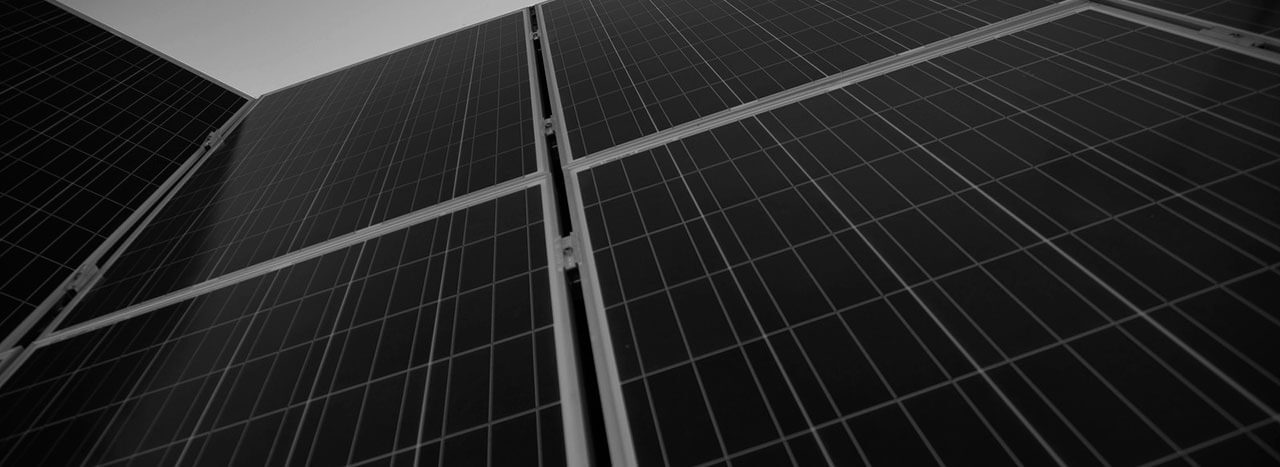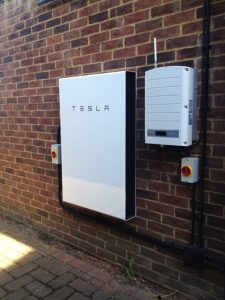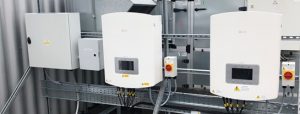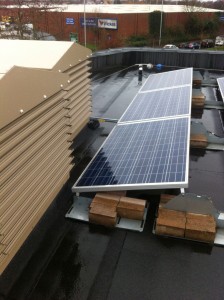What is an inverter?
If solar panels are the brawn behind your solar PV system, then the inverter is the brains. It is a critical component in good solar PV system design and performs four main functions.
- The inverter gets as much power as possible out of the panels. Components called maximum power point trackers (MPPTs) within the inverter ensure that the highest possible power is produced at all times, despite the constantly changing environmental conditions of the panels (light intensity, temperature, and colour of light).
- It converts the DC electricity produced by the solar panels into 240V AC electricity (or 400V AC electricity if a 3-phase system). The AC electricity can then feed directly into the AC electricity network within the building, ready for use.
- It matches the phase of the generated electricity to the phase of the grid. AC electricity can be considered as a sine-wave, and it is important that the peaks of this wave produced by the inverters coincide with the peaks on the grid.
- Because the inverter is constantly monitoring the grid status, if there is a power cut your inverter will turn off. This is because if an engineer needs to work on the power lines to fix a fault, they can’t have your solar PV array making those wires live. So for standard systems, solar PV will not provide you with electricity in a power cut. It is possible to ride through power cuts with battery systems – this moves the grid safety components to a separate box by your incoming supply.
Domestic inverters measure approximately 30x50x20cm (commercial units are larger and you may need more than one), so you will need to find space for this when your property is surveyed. These will typically go next to the fuseboard or under the stairs. Loft spaces are also possible, but they can get hot and cause inverter efficiency to drop. It is possible to install some inverter units on an outside wall as long as they are out of direct sunshine.
String inverters
Standard inverters are known as string inverters, because they take the input from a daisy-chain of solar panels called a string. Depending on the size of the system, systems may feature one string feeding one inverter, multiple strings feeding one inverter, or for commercial systems – many strings feeding multiple inverters.
The performance of a string is only as good as the weakest link in that chain. This means that avoiding shade on a solar PV array is very important – one shaded panel on a string of 20 panels could reduce the performance of all panels. Our design approach is to minimise shade on arrays wherever possible, even if this means installing fewer modules.
Inverters from Joju Solar
As with all technologies, Joju Solar are brand agnostic, and this is particularly important for inverters. We select inverters to optimise the output of the overall system, which in the UK means an inverter approximately 10% smaller than the size of the array. Straying too far from this ratio can adversely affect overall production.
Different manufacturers offer different sized inverters in their product range – one might offer 8, 10, and 15 kW, whereas another might offer 6, 9, and 13 kW. By offering more than one brand we can find the most optimally sized inverter, and give you the best performing system possible.
Inverters have improved technically over the past decade with most inverters now reaching 98% efficiency; that is to say 98% of the DC electricity from the panels is converted to AC electricity.
We offer string inverters from a range of manufacturers, including German manufacturers such as SMA, Fronius and ABB, as well as newer Chinese market entrants such as Huawei and Solis.
Optimisers
An alternative approach to string inverters is to use an approach known as optimisers. These allow each panel to operate independently, by putting small optimiser units (containing an MPPT) on the back of modules. This optimises the performance of each individual panel and increases overall system yield. It works in three ways:
- It helps mitigate the effects of shading – in the example above, one shaded panel out of 20 would only affect that one module if using optimisers.
- It gives a small increase in performance by dealing with module mismatch. When you buy a 270W module, it can actually be anywhere between 270 and 275W. For a string inverter approach the string performance would be limited by the worst module (270W). With optimisers, the 275W panels can perform as 275W panels. This can give an overall increase in yield of 1% or so.
- Overtime, debris such as bird poo can build up on some panels leading to a loss in performance. Again an optimiser system will limit the effects of this to only the affected modules rather than the whole string.
Joju Solar offer optimiser systems from SolarEdge who are the market leaders for this approach.
Why use SolarEdge?
The SolarEdge product, and optimisers in general, are good design options in the following situations:
- For roofs of different orientations. Under a string inverter approach, each different roof would need its own inverter, but a SolarEdge system can save costs by allowing panels facing different directions to be optimised separately and then feeding into a single inverter.
- Where there is localised shading at some times of day. Roof obstacles such as chimneys can cast shadows over one or two panels at certain times of day. An optimiser system can stop this affecting the performance of the whole array at these times. However, this should not be used as a carte blanche to install panels in heavily shaded environments. Heavily shaded panels such as the one below (not one of ours!) are always going to be shaded and should not be installed. SolarEdge has some great capabilities but it should not be an excuse for poor quality solar design.








